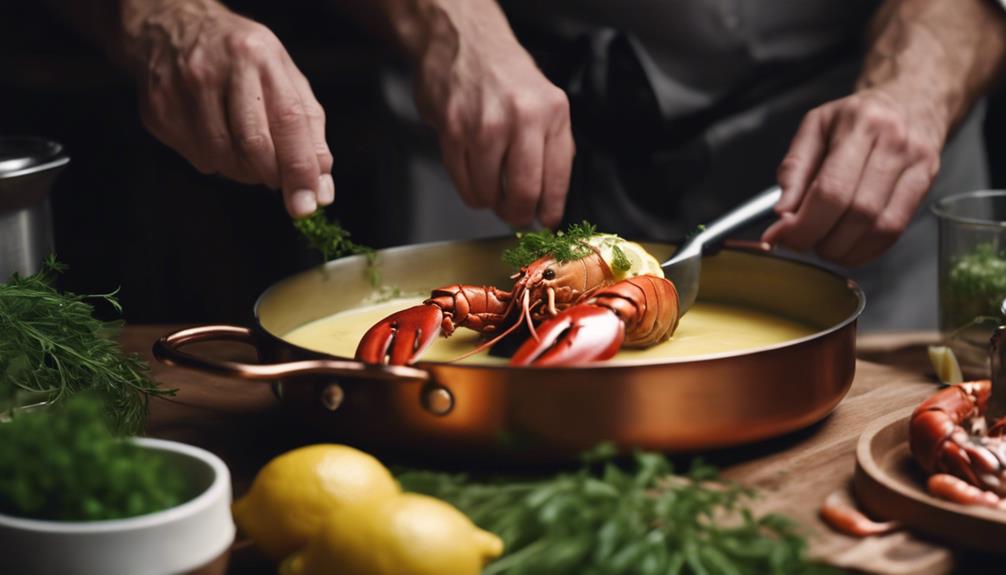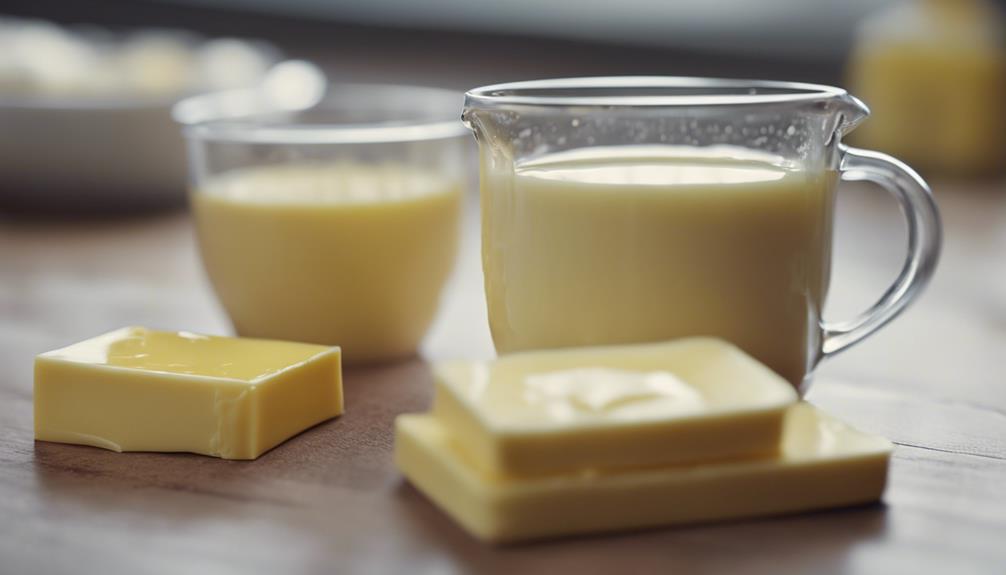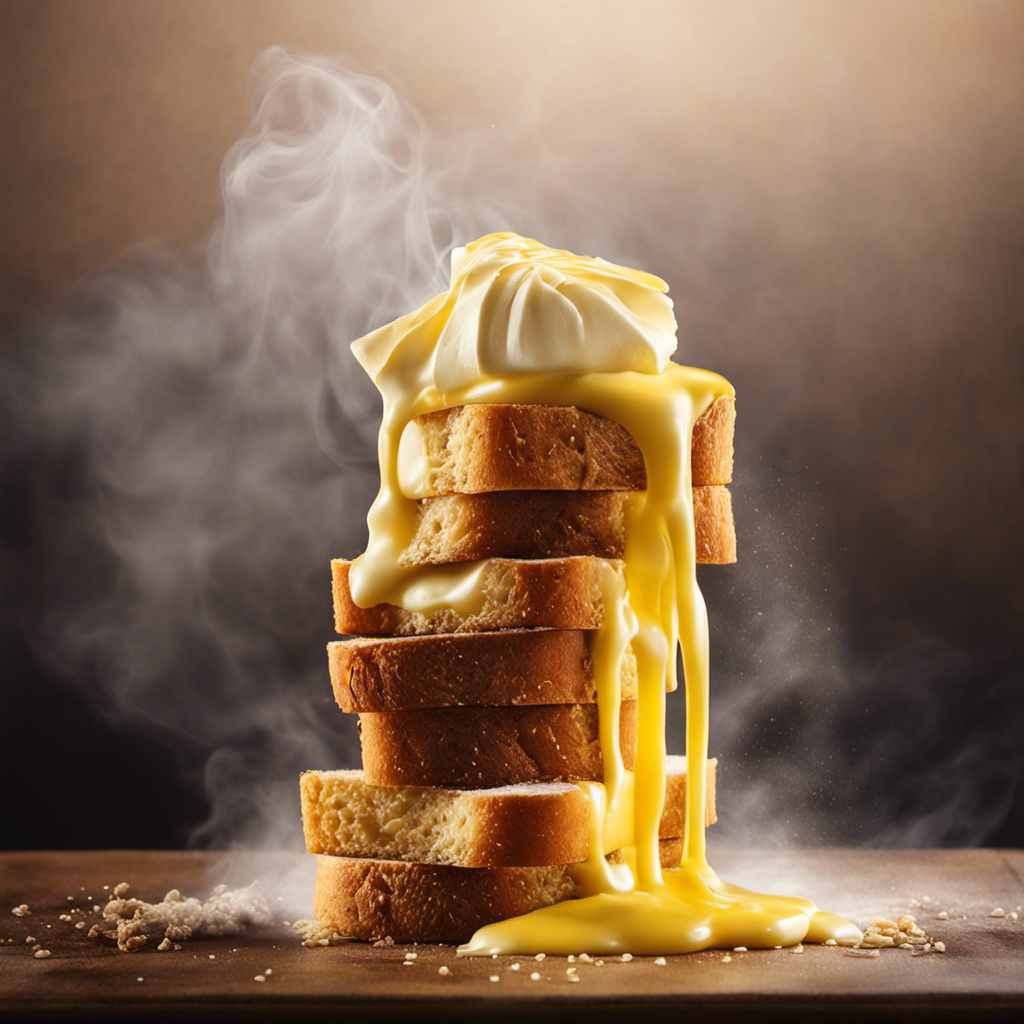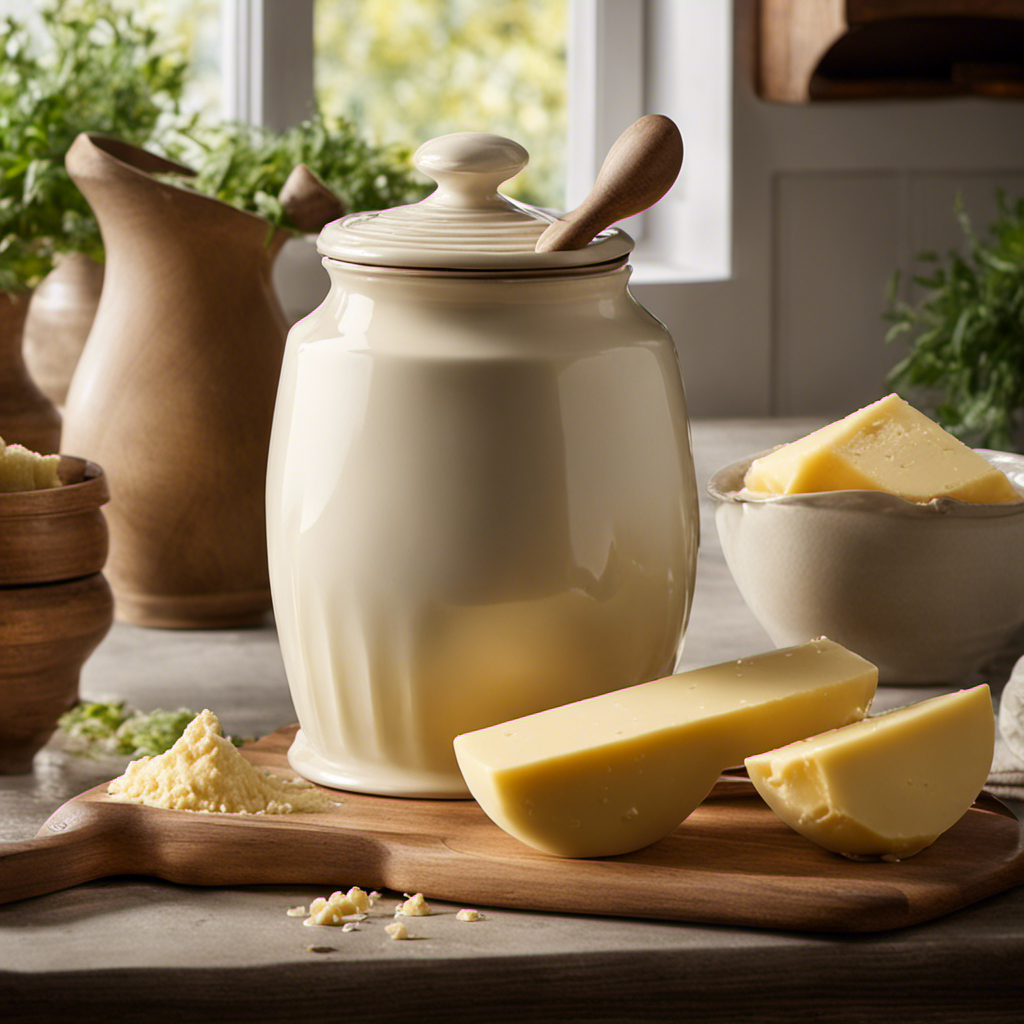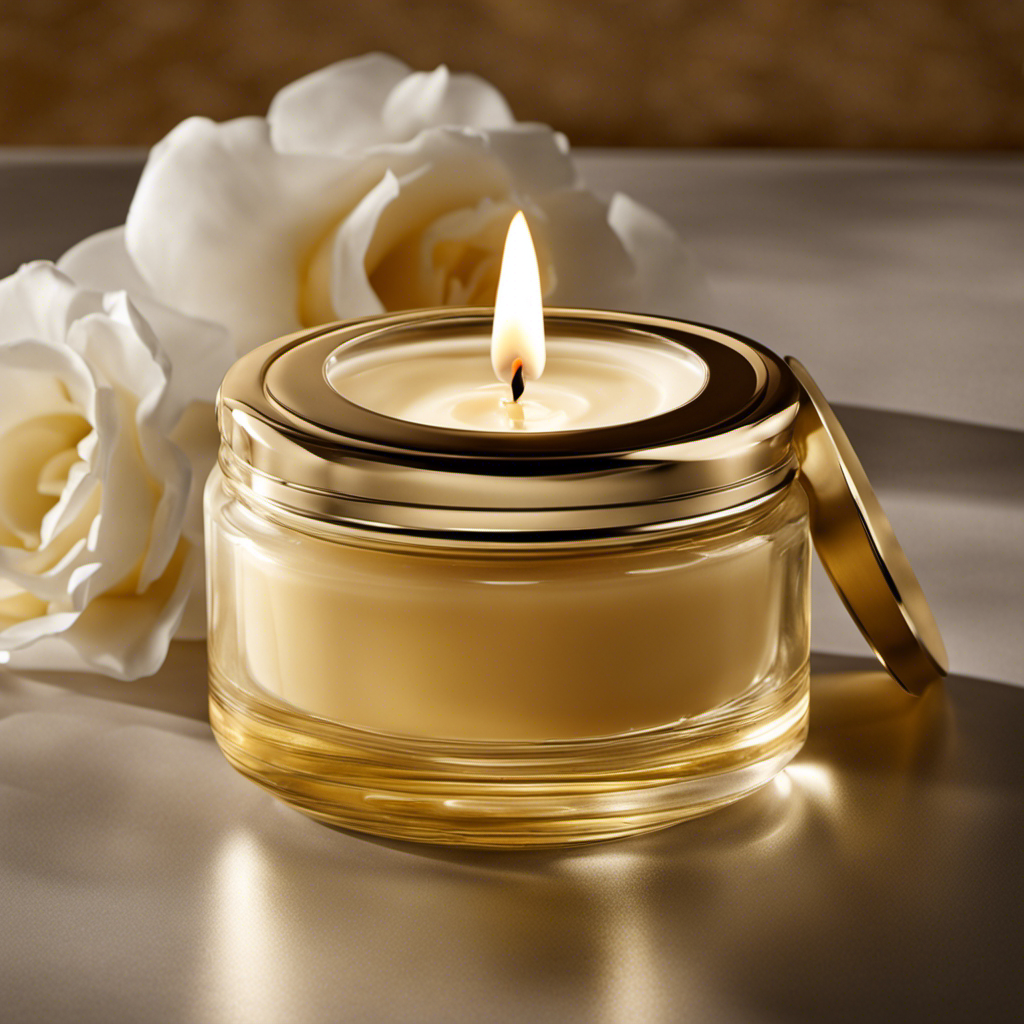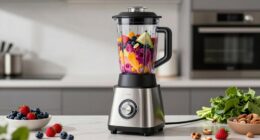To craft a gourmet lobster butter sauce, start by melting butter until it's lightly browned. Toss in minced garlic and a squeeze of fresh lemon juice. Stir in chopped cilantro and a sprinkle of freshly ground pepper. Season with salt, red chili flakes, cayenne pepper, and grated lemon zest. This sauce pairs perfectly with broiled lobster tails, which you can butterfly for an elegant presentation. Drizzle over grilled scallops, use as a dipping sauce, or mix with pasta. Store leftovers in the fridge for up to 5 days. Discover more tips to elevate your dish next.
Key Takeaways
- Melt butter until lightly browned and add minced garlic.
- Squeeze in fresh lemon juice and sprinkle freshly ground pepper.
- Incorporate chopped herbs like parsley, thyme, and chives.
- Season with salt, red chili flakes, cayenne pepper, and grated lemon zest.
- Serve sauce with broiled lobster tails or as a versatile condiment.
Ingredients Needed
You'll often need just a few simple ingredients to make a delicious lobster butter sauce. The basic components include butter, which forms the rich, creamy base.
Seasonings like salt and pepper are essential for enhancing the flavor. If you want to add a bit of zest, garlic is a fantastic option. Freshly minced garlic can give your sauce a delightful aroma and a hint of spice.
Lemon juice is another popular addition that can brighten the overall taste, making your lobster butter sauce more vibrant and tangy. Herbs like parsley, thyme, or chives can add a fresh, earthy touch, complementing the richness of the butter.
For those who enjoy a bit of heat, you might consider incorporating some red pepper flakes or a dash of cayenne.
Now, if you prefer a more straightforward flavor, you can stick to the basic butter and seasonings. However, having these optional flavorings on hand allows you to customize your lobster butter sauce to suit your taste preferences.
Whether you like it spicy, garlicky, or lemony, the key ingredients are versatile enough for you to experiment and find your perfect blend.
Preparation Steps
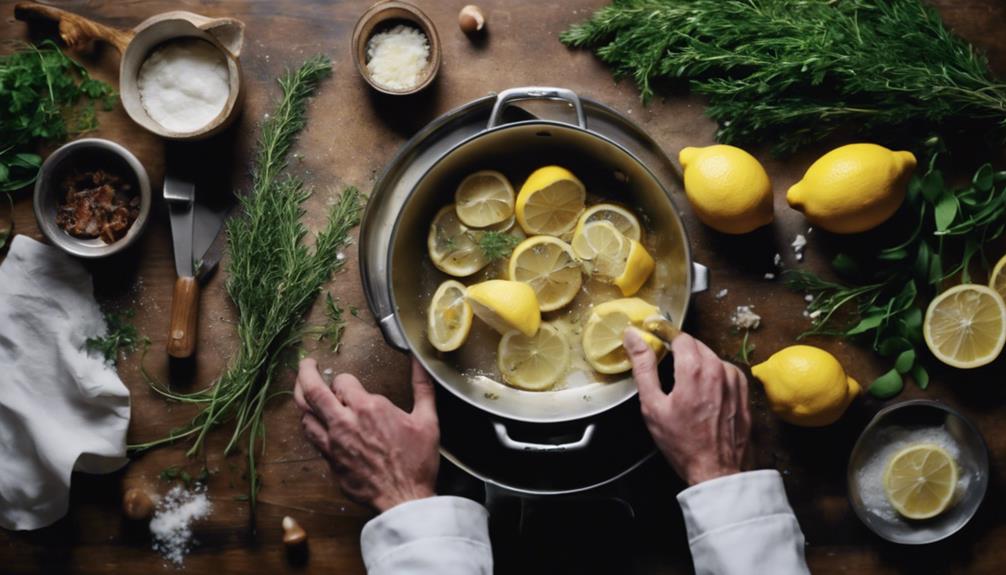
To start making your lobster butter sauce, begin by butterflying the lobster tails to access the rich flavors within.
Next, prepare a garlic butter sauce by melting butter and adding minced garlic.
Butterflying Lobster Tails
For butterflying lobster tails, start by cutting the top of the shell lengthwise and gently pulling the meat halfway out. This technique not only makes your lobster tails look stunning but also guarantees they cook evenly. Begin by using kitchen shears to cut through the top shell of each lobster tail, from the wide end down to the tail fin. Be careful not to cut the meat itself.
Next, carefully spread the shell apart and use your fingers to lift the lobster meat. Pull the meat halfway out, letting it rest on top of the shell while still attached at the base. This step is essential for allowing seasonings to penetrate the meat more effectively, enhancing flavor.
You can place lemon wedges under the meat before cooking to add a touch of citrusy zing and improve presentation. This method also ensures that the meat is slightly elevated, so it cooks more evenly.
Butterflying lobster tails is a common preparation method for recipes like grilled lobster tails with garlic butter sauce. It results in more flavorful and succulent meat, making your dish a real showstopper.
Garlic Butter Sauce
Start by melting butter in a saucepan over medium-low heat until it's lightly browned. This creates a nutty, rich base for your garlic butter sauce. Once the butter reaches that perfect golden hue, add minced garlic to the pan. Stir frequently and cook the garlic until it's fragrant but not browned—this usually takes about 1-2 minutes.
The aroma will be irresistible, infusing the butter with its savory essence.
Next, reduce the heat to low to prevent burning. Squeeze in some fresh lemon juice for a zesty kick and a balanced flavor profile. Add chopped cilantro for a fresh, herbal note, and sprinkle in some freshly ground pepper to taste. These elements elevate the sauce, giving it layers of complexity that perfectly complement lobster tails and other seafood dishes.
Allow this delightful mixture to steep over low heat for about 10 minutes. This process melds the flavors together, making the garlic butter sauce even more luscious and aromatic. Stir occasionally to make sure everything blends smoothly.
Once done, your garlic butter sauce is ready to enhance your gourmet lobster dish, adding a luxurious touch that will impress your guests.
Seasoning and Serving
Now that your garlic butter sauce is ready, it's time to season and serve your lobster butter sauce for an unforgettable dining experience. Start by adding a splash of zesty lemon juice and a pinch of salt to bring out a classic flavor profile that complements the rich, buttery texture. If you prefer a bit of heat, sprinkle in some red chili flakes and a dash of cayenne pepper for a spicy kick.
To enhance the aromatic quality of your sauce, incorporate some finely minced garlic. This will deepen the flavor and give your butter sauce a rich, savory undertone. For a revitalizing twist, grate in a bit of lemon zest. The zest adds a tangy finish that brightens up the overall taste of your sauce.
Here's a quick reference table to guide your seasoning process:
| Ingredient | Purpose |
|---|---|
| Fresh lemon juice | Adds a classic, tangy flavor |
| Salt | Enhances overall taste |
| Red chili flakes | Introduces a spicy kick |
| Cayenne pepper | Adds heat and depth |
| Lemon zest | Provides a invigorating, tangy finish |
Cooking Instructions
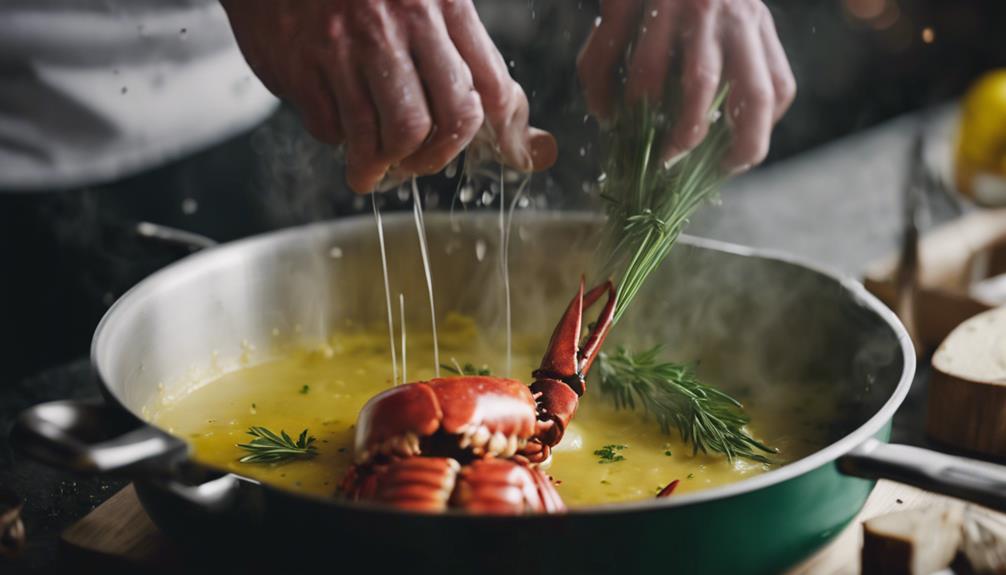
To create a delectable lobster butter sauce, start by butterflying the lobster tails for a sophisticated and easy-to-enjoy presentation. Use a sharp pair of kitchen shears to carefully cut down the center of each tail's shell, stopping just before the tail fan. Gently pry open the shell, exposing the meat, and lift it slightly to rest on top of the shell. This technique not only makes the lobster look impressive but also guarantees even cooking.
Preheat your broiler to high. Place the prepared lobster tails on a baking sheet, shell side down. Broil the lobster tails for about 10-12 minutes, or until the meat turns white and opaque. Be cautious not to overcook them, as lobster can quickly become tough.
While the lobster tails are broiling, prepare your garlic butter dipping sauce. Melt butter in a small saucepan over medium heat, then add minced garlic, cooking until fragrant. This rich, flavorful sauce will complement the lobster beautifully.
Once the lobster is done, serve the tails with the garlic butter sauce on the side. Garnish with freshly chopped parsley for a touch of color and added flavor. Enjoy your gourmet lobster butter sauce meal!
Flavor Variations
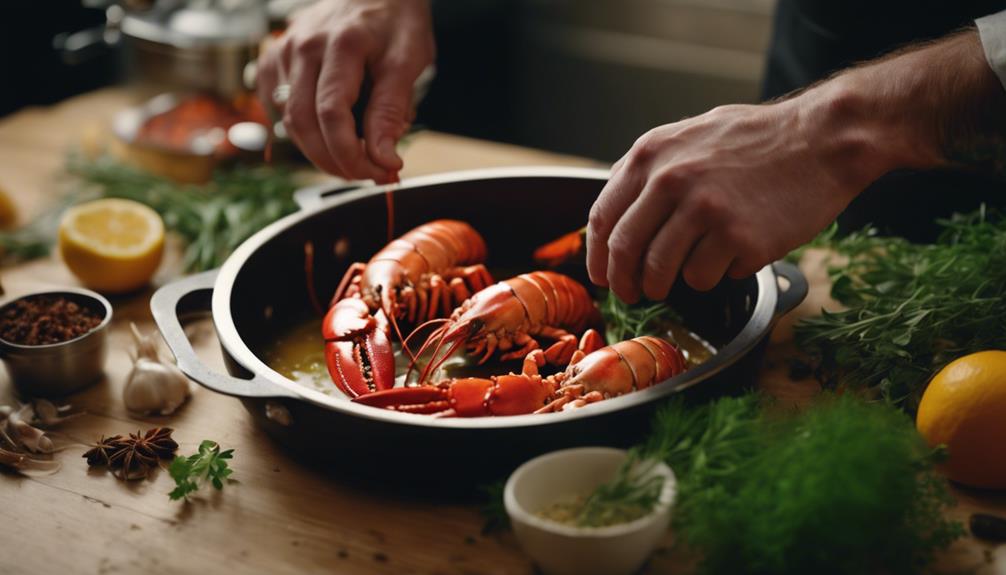
While the classic garlic butter sauce is a crowd-pleaser, experimenting with flavor variations like lemon zest, spicy paprika, or fresh herbs can take your lobster butter sauce to new heights. Adding a touch of lemon zest introduces an invigorating citrus note that balances the richness of the butter.
A sprinkle of spicy paprika adds a delightful kick for those who enjoy a bit of heat. Fresh herbs like parsley, dill, or tarragon can infuse the sauce with vibrant, aromatic flavors that complement the natural sweetness of the lobster.
To create these variations, start with your base garlic butter sauce. For a lemony twist, grate some lemon zest directly into the sauce and stir well. If you're in the mood for a zesty version, add a pinch of paprika or even some crushed red pepper flakes.
Fresh herbs can be finely chopped and stirred into the sauce just before serving to maintain their bright, fresh taste.
Storage Tips

When storing your lobster butter sauce, you can refrigerate it for up to 5 days or freeze it for up to 6 months.
Follow the freezing tips in the recipe notes to guarantee the best quality.
When you're ready to serve, simply reheat the sauce to enjoy its full flavor.
Refrigeration and Freezing Methods
Storing your lobster butter sauce correctly guarantees it remains delicious and ready for future meals. When it comes to refrigeration, you can keep your sauce fresh for up to 5 days. Make sure to store it in an airtight container to prevent any unwanted odors from affecting its rich, buttery flavor. Once you're ready to use it, simply warm it up gently on the stove to retain its creamy consistency.
For longer-term storage, freezing is your best bet. Lobster butter sauce can be frozen for up to 6 months without compromising its taste. To freeze, let the sauce cool completely before transferring it to a freezer-safe container or a heavy-duty zip-top bag. Lay the bag flat in the freezer for easy stacking and quicker thawing later on.
When you're ready to enjoy it, thaw the sauce in the refrigerator overnight, then gently reheat on the stove.
Optimal Shelf Life
Ensuring your lobster butter sauce maintains its best shelf life involves careful attention to storage practices. Store your butter sauce in the refrigerator for up to 5 days. Make sure to use an airtight container to keep it fresh and prevent any unwanted flavors from seeping in. If you need to keep it longer, freezing is your best bet.
To freeze lobster butter sauce, transfer it to a properly sealed container or freezer bag. This will help maintain its quality and freshness for up to 6 months. Be sure the container is airtight to avoid freezer burn, which can compromise the sauce's flavor and texture.
When you're ready to use the frozen butter sauce, place it in the refrigerator overnight to thaw. This gradual thawing process helps preserve the sauce's consistency and flavor. Once thawed, you can proceed with reheating, but remember, we'll cover those steps in the next section.
Reheating Instructions
To reheat your lobster butter sauce, gently warm it in a saucepan over low heat. Stir occasionally to maintain even heating and to prevent burning. This method preserves the sauce's rich, buttery texture and exquisite flavor. Avoid using high heat as it can lead to separation or scorch the delicate butter sauce.
For storage, you can refrigerate the lobster butter sauce in an airtight container for up to three days. When you're ready to use it, follow the gentle reheating instructions. If you need to store it longer, freezing is an excellent option. Pour the sauce into a freezer-safe container, leaving some space at the top for expansion. Label it with the date so you remember when you made it.
When reheating frozen lobster butter sauce, thaw it overnight in the refrigerator. Once thawed, transfer it to a saucepan and warm it over low heat, stirring occasionally. This gradual reheating process ensures the best texture and flavor.
Proper storage and careful reheating will keep your lobster butter sauce tasting fresh and delicious, ready to enhance any dish you pair it with. Taking these steps guarantees that your butter sauce remains a delightful, gourmet touch to your meals.
Serving Suggestions

For an unforgettable dining experience, drizzle lobster butter sauce over grilled scallops or fresh shrimp. The rich, creamy sauce, with its luxurious lobster essence, perfectly complements the natural sweetness of the seafood. To enhance the flavor, consider adding a hint of minced garlic to the sauce. This small addition brings a savory depth that pairs beautifully with both scallops and shrimp.
You can also use lobster butter sauce as a dipping sauce for lobster tails or crab legs. The warmth and richness of the sauce will elevate the succulent meat, making each bite a delightful explosion of flavors. For a touch of brightness, a squeeze of lemon juice can be added, balancing the richness with a zesty kick.
If you're serving pasta, toss it with lobster butter sauce for a decadent twist on a classic dish. The sauce clings to the pasta, ensuring every forkful is bursting with flavor. You can even pour it over a perfectly cooked steak, adding an indulgent, seafood-inspired touch.
No matter how you choose to serve it, lobster butter sauce is a versatile condiment that can elevate any meal to gourmet status.
Nutritional Information
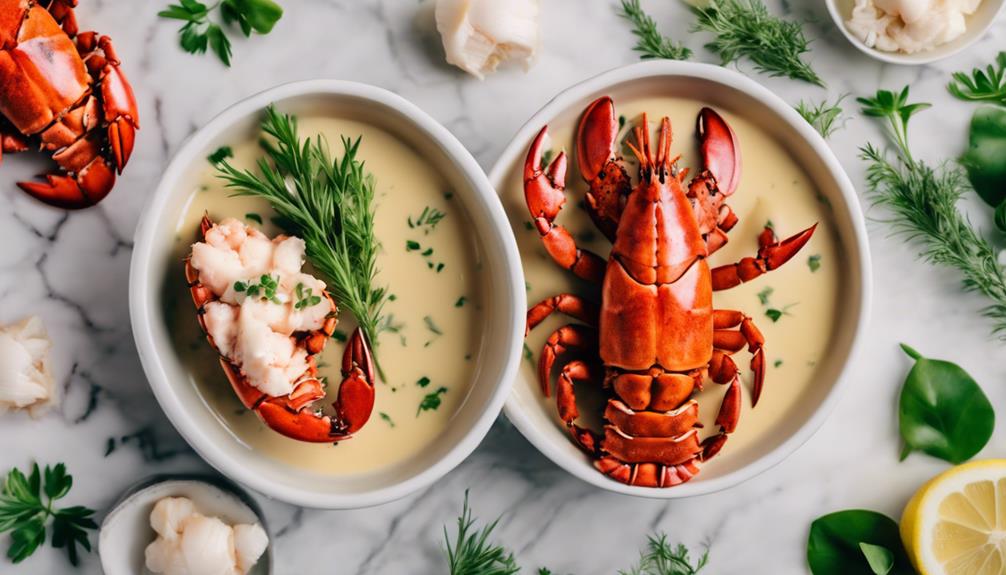
Now that you know how to serve lobster butter sauce, let's look at its nutritional profile to make informed choices.
A single serving of this indulgent sauce, paired with Maine lobster, packs around 204 calories. It offers 11 grams of protein, making it a decent source of this essential nutrient. However, the fat content is something to be mindful of, with 18 grams of fat, including 11 grams of saturated fat.
If you're following a 2,000 calorie diet, these numbers might be significant. Depending on your dietary needs, you can make some variations to fit your lifestyle.
For instance, using ghee can make a Whole30-compliant version, and dairy-free butter can cater to those with dairy sensitivities.
User Reviews and Ratings

User reviews and ratings provide valuable insights into the popularity and quality of lobster butter sauce recipes. When you're deciding whether to try a new dish, these ratings can be incredibly helpful. Ratings typically range from 1 to 5 stars, and our lobster butter sauce recipe has garnered a rating of 139. This high rating indicates that many users have enjoyed and appreciated the recipe.
To leave a rating, you'll need to log in or sign up on the platform. This not only allows you to rate recipes but also lets you mark them as cooked for easy tracking. It's a great way to keep a digital record of your culinary adventures.
Additionally, you can add private notes to the recipe. These notes can include helpful tips, adjustments, or just your personal experience, making it easier for you to replicate or tweak the recipe next time.
User interaction through reviews and ratings fosters a sense of community. By sharing your thoughts and reading others' experiences, you enhance your own cooking journey and help others along the way.
Frequently Asked Questions
What Is Lobster Butter Sauce Made Of?
Lobster butter sauce is made of butter, seasonings, and sometimes lemon juice. You can enhance it with garlic, red chili flakes, cayenne, or lemon zest. It's typically served warm and pairs perfectly with seafood dishes.
What Kind of Butter Do Restaurants Use for Lobster?
Restaurants often use unsalted or clarified butter for lobster to manage salt levels and enhance flavor. They might choose high-quality European-style butter or locally sourced options for a premium touch. Herb-infused butter adds complexity.
What Is Lobster Sauce Made Of?
Lobster sauce, dude, is made of butter, garlic, lemon juice, herbs, and lobster drippings. You can jazz it up with red chili flakes, cayenne pepper, or lemon zest. It's versatile and elevates any seafood dish!
What Is Lobster Cream Sauce Made Of?
You'll need heavy cream, butter, and lobster meat or broth. Enhance the flavor with shallots, garlic, white wine, and herbs. Thicken it with flour or cornstarch. Optional additions include cognac, tomato paste, or Parmesan cheese.
Conclusion
So, you've mastered the art of making lobster butter sauce—congratulations! Who knew that melting some butter and adding lobster could elevate you to gourmet chef status?
Now, you can wow your dinner guests with this 'complex' recipe that took all of 20 minutes. But hey, don't let the simplicity fool them; let them think you've spent hours in the kitchen. Sometimes, the secret ingredient really is just a touch of irony.
Bon appétit!
